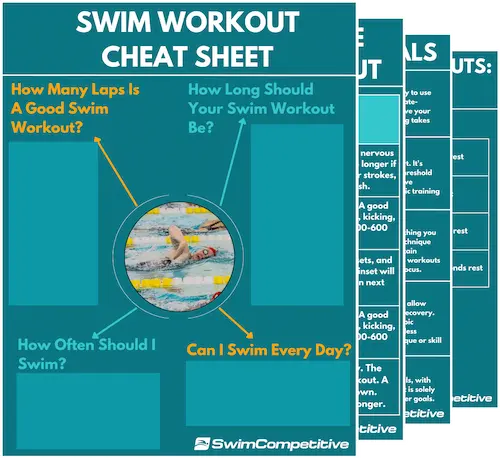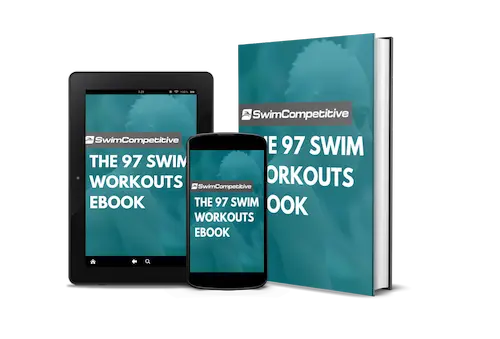Are you having a hard time getting through your swimming workouts? Does swimming front crawl tire you out and make you feel like you’ll never reach your swimming and fitness goals? Don’t worry! Because in today’s article I will be giving you some useful tips on how to swim front crawl without getting tired so that you can crush your swimming workouts, swim those laps, and burn those calories.
The front crawl is easily the most well-known swimming stroke and is often the first stroke taught to beginner swimmers along with the breaststroke. Front crawl is also known as the freestyle and it’s the fastest swimming stroke with the 100m front crawl world record standing at a blitzing time of 46.91 currently held by César Cielo from Brazil.
The front crawl works almost the entire body while placing a large emphasis on muscle groups such as the delts, lats, traps, triceps, and biceps, making it a great way to tone your upper body while significantly improving your cardiovascular fitness. Not to mention, you’ll also be able to burn up to 280 calories in just 30 minutes by swimming front crawl.
So with all that said, let’s see how you can swim front crawl without getting tired and reap all of those nice benefits mentioned above.
Here are a few tips for swimming front crawl without getting tired-
- Perfect your body position while swimming front crawl.
- Learn the proper front crawl breathing technique.
- Focus on swimming with long strokes.
- Train your front crawl more often.
- Improve your overall front crawl swimming technique.
- Work on your mobility and flexibility outside of the water.
- Fuel your body with the right nutrients.
- Utilize controlled speed while swimming front crawl.
1. Perfect Your Body Position in the Water
One of the best ways to reduce the amount of effort you have to put in while swimming front crawl, and thus allowing you to avoid getting tired, is by reducing the amount of resistance the water places on your body.
One of the easiest and most effective ways for reducing water drag and resistance is by having a good body position while swimming front crawl.
This is often the first thing taught to young or beginner swimmers, and it will continually be improved and worked on by coaches and the swimmer through the years as swimmers progress further and further and become faster and more experienced.
It’s, however, not necessary to stress about this too much, unless you are a competitive swimmer looking to maximize speed in the water as much as possible. For the majority of swimmers, a basic body position is going to be just fine. Sure, you should definitely aim to improve it but once you have a decent body position you’re already going to be miles ahead.
Here are the guidelines for a good body position while swimming front crawl-
- Keep your body as flat as possible, aim to maintain a straight line with your body.
- Your head should be looking slightly forward and down, but not too far forward (so that you see the wall) or too far backward (so that you see your toes).
- Also aim to keep your head as still as possible, it shouldn’t be moving from side to side or up and down.
- Ensure that your hips rotate around your core while keeping your back as flat as possible and pulling your stomach in.
- Hold a consistent kick throughout your stroke and don’t be afraid to “role” slightly sideways with each stroke as you swim.
Here is a quick video that will explain it in a more visual way-
2. Learn Proper Front Crawl Breathing Technique
If you want to avoid getting tired while swimming front crawl, you should definitely make sure that your breathing technique is top-notch.
Proper breathing will ensure that you’re able to consume optimal amounts of oxygen with each breath. And in return this will help your body to power all of its internal processes, which will allow you to swim more efficiently, ultimately reducing fatigue.
You might not completely be aware of how big of a role oxygen actually plays in the muscles. If you aren’t consuming enough oxygen, your body won’t be able to break down glucose and create fuel for your muscles. This fuel is known as ATP energy and the process is known as cellular respiration.
If you don’t provide your muscles with enough oxygen you’ll fatigue really quickly. And apart from looking at the pure side of oxygen consumption you also need to take note that the way you move your head and body while breathing could create resistance in the water- simply another reason to learn the proper breathing technique.
Basic front crawl breathing technique can be broken into 3 main stages-
1. Keep your face in the water while swimming. Initially, this may be quite challenging and uncomfortable, but it is a critical part of developing good breathing technique and good front crawl technique in general. If you swim with your head up, your lower body will drop and you’ll break the body-position we discussed earlier, thus creating more resistance in the water.
2. Exhale while your head is underwater. This is a really basic concept, but it can actually have a huge impact on your stroke and oxygen consumption. If you’re trying to breathe in and out every time you lift your head, you’ll increase the time you have to lift your head, allowing for a higher chance of compromised body position, and you’ll also only consume a little bit of oxygen.
The most effective way to go about things is to exhale under the water as you are swimming, so when you do come up for a breath your lungs are already empty and you can simply take a breath and put your head back down again.
3. Breathing to one side. This is very important for developing good front crawl swimming technique and providing a reliable flow of oxygen through your body as you swim. It’ll also help you to maintain a good rhythm while swimming without slowing you down.
So with that said, if you are looking for some extra breathing exercises that you can do to improve your breathing mechanics and lung capacity consider checking out my article on the best pool and dryland breathing exercises for swimmers.
3. Focus on Long Strokes While Swimming Front Crawl
Taking long strokes while maintaining a good body position will significantly reduce the energy cost of swimming and will allow you to swim more efficiently. And as a bonus- you’ll look like a pro.
To achieve this, focus on reaching as far forward as you can every time your hand enters the water. You should feel a nice stretch in your lat as you reach forward with each stroke. Make sure to use a good amount of power while pulling back to ensure that you propel yourself forward as your other arm comes over and does the same thing.
This will allow you to form a good rhythm thus allowing you to swim front crawl without getting tired. In the beginning, it won’t come naturally, and you’ll definitely have to make a conscious effort of reaching forward every time. But as you grow used to the motion you’ll start doing it without even thinking about it. The key is to just stay consistent.
4. Train Your Front Crawl More- the Fitter You Are the Easier It Becomes
Providing you with all of these tips and techniques to swim front crawl without getting tired is all good and well, but it isn’t actually going to benefit you in any way if you don’t train your front crawl on a regular basis.
You will never be able to swim front crawl without feeling tired if you haven’t first developed some good fitness and put in the effort to actually learn good body position while implementing the other tips that I have mentioned and still need to talk about in this article.
With that said, you might be wondering- “now how often should I actually train and how much should I do?”. While there is no specific answer to this I can give you some nice guidelines. I actually wrote an entire article on that topic and you can check it out by clicking here. I also discuss some other swimming tips there that you might find useful.
Do You Want to Make Every Lap Count?
Stop wasting your time in the pool feeling lost and doing directionless swim workouts, and start training effectively! Our ebook contains 97 structured and goal-orientated swim workouts to help you become a better, faster, and fitter swimmer. Whether you’re a complete beginner or a seasoned pro, there are a multitude of workouts for every type of swimmer.
5. Improve Your Front Crawl Swimming Technique
As we’ve already discussed, reducing your resistance in the water is a huge part of being able to swim freestyle without getting tired. There are a lot of technical aspects that you can focus on perfecting that will reduce your drag in the water and make it easier for you to swim without getting tired.
But apart from that, there are also other technical aspects that you can focus on that will increase your efficiency in the water, for example, you can work on pulling not only with your hands but also with your forearms thus increasing your propulsion and allowing you to complete your workouts faster without using a lot more energy or putting in much more effort.
When you are continually improving different parts of your front crawl technique you’ll soon be able to swim uninterruptedly without ever feeling like you are getting tired.
And trust me, there are hundreds of little details that can be improved, for example- hand entry, head position, kicking pace (3 beat, 6 beat 12 beat kick and so on), body roll, utilizing your body surface to the fullest, optimal hip position and so the list goes on.
Find a few things to work on and continually mix it up between those technique aspects until you’ve become really good at them. Then find the next set of things to work on and perfect them. After that, you can go back to the first set and improve them even further or you might choose to focus on another set of technique improvements.
I also recommend checking out some freestyle drills since these are an easy way to isolate specific parts of your stroke and improve your technique at a faster rate. I recommend checking out “the swimming drill book” by Ruben J. Guzman on Amazon for some nice drills, click here to view it.
You might also want to check out another book simply, yet effectively named “the 100 best swimming drills” by Blythe Lucero, just click here to view it.
6. Work on Your Mobility and Flexibility Outside of the Water
The next tip is simple, but can actually have a huge impact on your performance in the water and can easily make swimming feel much easier and less tiring.
As a swimmer you should always be aiming to improve your flexibility, this will ensure that muscles don’t get tight, stiff, and overworked, which is, unfortunately, the case for a lot of competitive swimmers due to the repetitive motions performed day in and day out.
Doing simple static stretches after training will increase your flexibility, while dynamic stretches before training will loosen up the muscles and get them warm and ready to perform. Also, consider doing some foam rolling to break up tight muscle tissue and to get the blood flowing.
7. Fuel Your Body with the Right Nutrients
Ensuring that your nutrition is correct will also play a big role in how you feel while swimming. If you are constantly consuming a bunch of unhealthy processed food, your body won’t be able to perform and recover as effectively as someone who is eating healthy and focusing on consuming more organic sources of food such as rice, potatoes, eggs, nuts, milk, and the occasional serving of pasta for some extra energy.
It’s also important to ensure that you are consuming good amounts of micronutrients from foods like vegetables and fruits. You may even choose to use an electrolyte drink during training to replace any electrolytes that your body may be losing through sweat, thus keeping your performance at a high-level. (For more info on supplements for swimmers, refer to this article).
When you are constantly eating healthy you will be able to swim faster and longer without getting tired since your body will be fueled with all of the right nutrients it requires to function correctly during physical exercise.
8. Use Controlled Speed When Swimming Front Crawl in Races
For those of you who may be into competitive or masters swimming, this is going to be an essential part of being able to swim a good race without completely falling apart and losing all of your momentum (not until the end at least) on those longer races.
It’s a concept nicknamed “controlled speed” and it means to swim at a fast and controlled pace, but not going all out, until the last bit of your race. For example, you may be able to swim a 50 freestyle in a time of 25.40, but that will require all of your energy and power. Now with controlled speed, you will probably be able to swim a 25.98 and you’ll be nowhere near as tired.
This concept should be applied to longer front crawl races. Personally, I even use it in my 100 freestyle races. It’ll help you to avoid getting tired right off the bat allowing you to maintain a good speed until the end, say last 50 or 25 where you’ll let loose and give it whatever you have left.
Apply Our Tips to Swim Front Crawl Without Getting Tired
The first step in becoming a good swimmer is ensuring that you are able to swim a fluent front crawl for at least an 800 without getting tired. This is going to take time, but if you implement the advice given in this article and you stay consistent with your training you’ll be able to reach that goal in no time.





